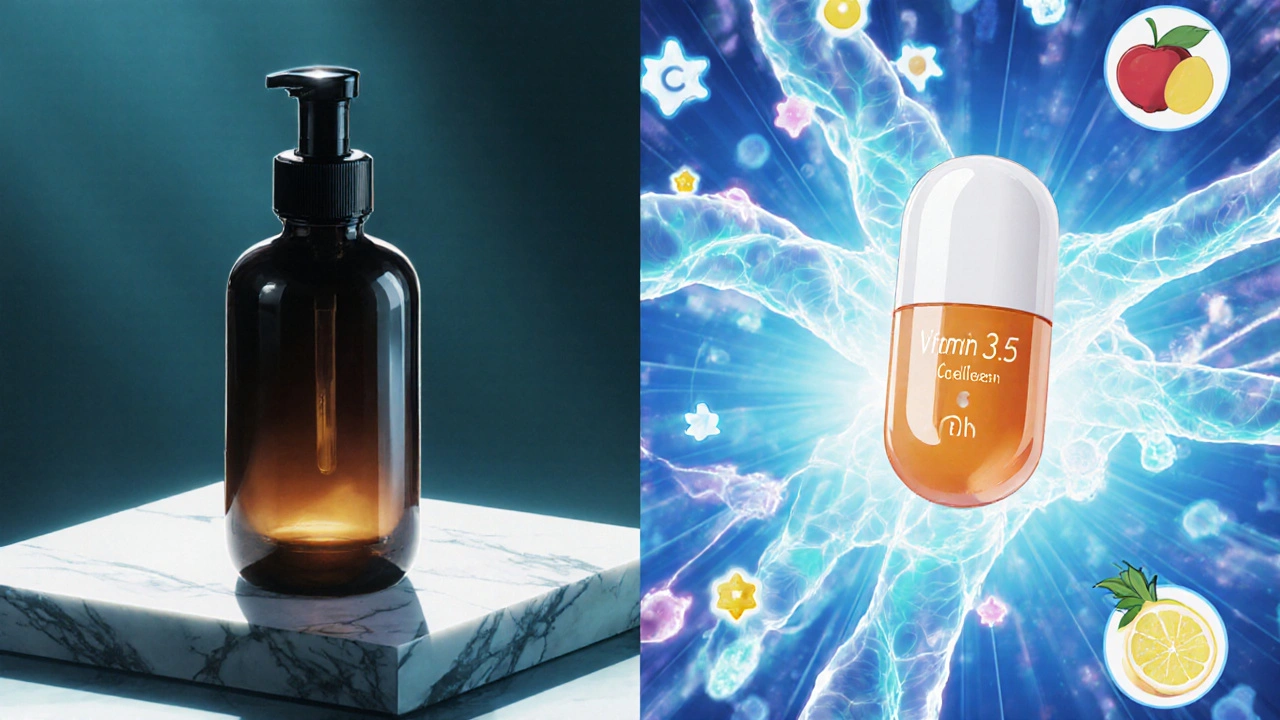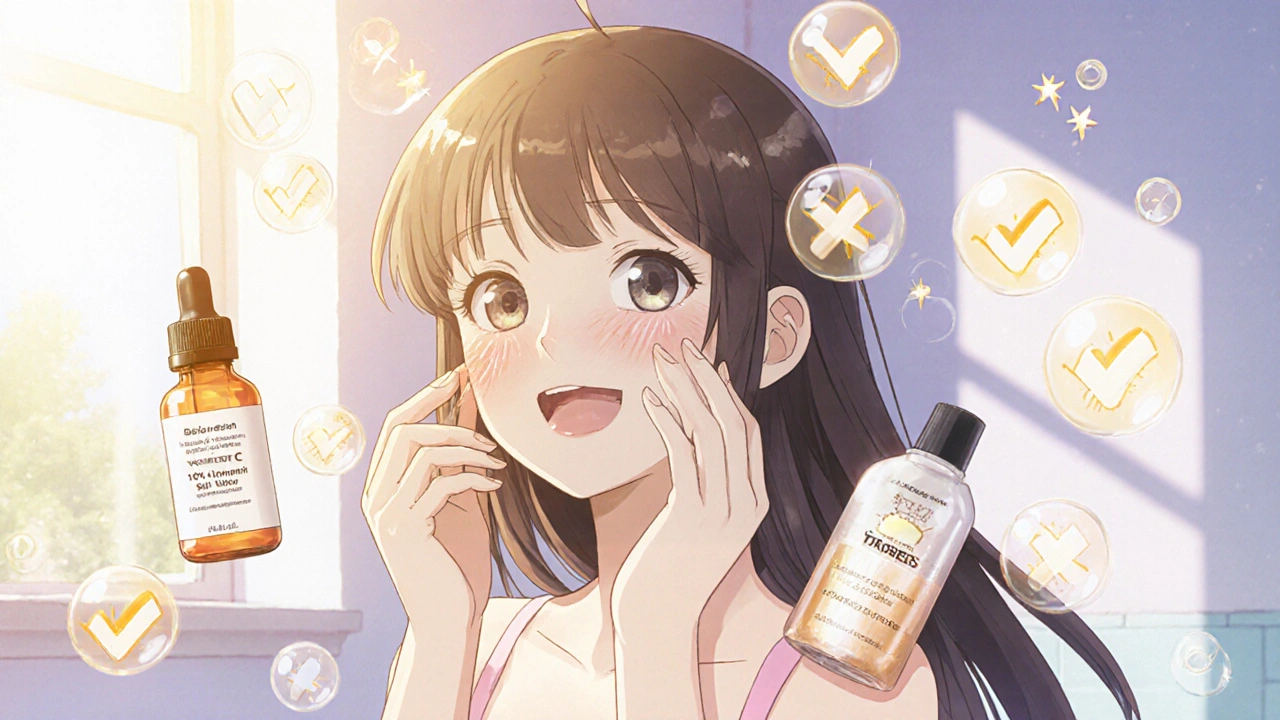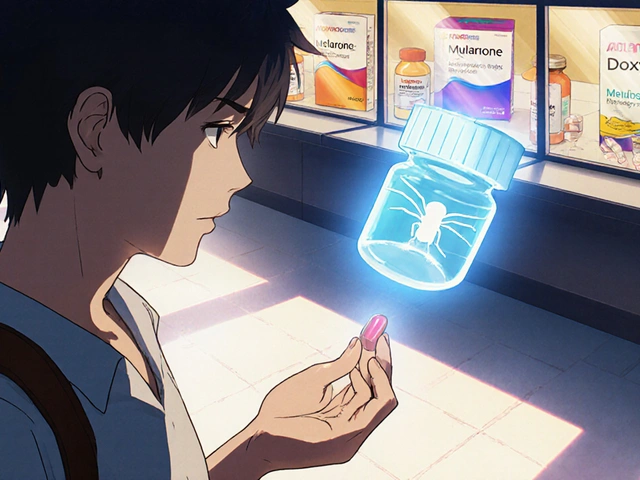Vitamin C Product Checker
Check if your Vitamin C product meets the scientific criteria for effectiveness and stability based on the article content.
Key Takeaways
- Vitamin C protects skin from free‑radical damage and boosts collagen production.
- Topical serums deliver quick results, while oral supplements support long‑term skin repair.
- Choose stable forms (L‑ascorbic acid, magnesium ascorbyl phosphate) and combine with sunscreen for best protection.
- Typical side‑effects are mild (tingling, slight redness); severe reactions are rare.
- Integrate Vitamin C into a simple morning routine: cleanse, apply serum, moisturize, and finish with SPF.
What Vitamin C Actually Does for Your Skin
When it comes to keeping skin smooth, Vitamin C is a water‑soluble antioxidant that helps protect cells from oxidative stress and supports collagen production. In plain English, it works like a shield against the invisible enemies that age our faces - mainly free radicals created by UV exposure, pollution, and even the natural metabolism of skin cells.
Free radicals are unstable molecules that chase electrons, damaging proteins, lipids, and DNA. In skin, that damage shows up as fine lines, loss of firmness, and uneven tone. Vitamin C steps in, donating an electron to neutralise the radical without becoming a threat itself. The result? Less collagen breakdown and more new collagen being built.
Collagen, the structural protein that gives skin its plumpness, is synthesised by Dermal Fibroblasts cells in the deeper layer of skin that produce collagen and elastin fibers. Vitamin C is a co‑factor for the enzyme prolyl‑hydroxylase, which is essential for stabilising the collagen triple‑helix. Without enough Vitamin C, fibroblasts can’t finish the collagen assembly line, leading to weaker skin scaffolding and, eventually, wrinkles.
Topical vs. Oral: How Each Route Works
Both skin‑applied serums and oral supplements increase Vitamin C levels, but they do it in different ways. Below is a quick side‑by‑side look.
| Aspect | Topical Serum | Oral Supplement |
|---|---|---|
| Absorption Speed | Immediate - works on the skin surface within minutes. | Slower - must travel through digestion, bloodstream, then skin. |
| Typical Concentration | 5‑20 % L‑ascorbic acid (stable forms can be lower). | 500‑1000 mg per day (often as calcium or magnesium ascorbate). |
| Primary Benefit | Brightening, immediate antioxidant protection, surface collagen boost. | Systemic antioxidant support, long‑term collagen synthesis, overall health. |
| Stability Issues | Highly sensitive to air, light, and heat - needs opaque packaging. | Generally stable; concerns mostly about gastrointestinal tolerance. |
| Best Use Case | Targeting early signs of aging, uneven tone, and sun‑damage spots. | Supporting overall skin health, especially when diet lacks fresh fruits/veg. |
Because the skin barrier limits how much Vitamin C can penetrate, a high‑quality serum with a stable form (like magnesium ascorbyl phosphate) combined with a low pH environment (around 3.5) yields the best results. Oral supplements, on the other hand, are great for filling dietary gaps and keeping overall antioxidant levels up.

Choosing the Right Vitamin C Product
Not all Vitamin C products are created equal. Here’s a quick checklist to avoid common pitfalls:
- Form matters. L‑ascorbic acid is the most researched, but it’s also the least stable. Look for derivatives such as sodium ascorbyl phosphate or tetrahexyldecyl ascorbate if you have sensitive skin.
- Concentration. For beginners, 5‑10 % is enough to see a change without irritation. Experienced users can push to 15‑20 % if their skin tolerates it.
- Packaging. Dark glass or air‑tight pump bottles protect the antioxidant from oxidising.
- pH level. A serum that sits at pH 3‑4 allows the molecule to stay in its active, neutral form.
- Complementary ingredients. Vitamin E, ferulic acid, and hyaluronic acid boost stability and enhance hydration.
When buying a supplement, aim for a reputable brand that lists the exact form of Vitamin C and provides third‑party testing. Avoid mega‑doses (>2000 mg) unless a healthcare professional advises it; excess Vitamin C is excreted but can cause stomach upset.
Integrating Vitamin C Into Your Daily Routine
Consistency beats occasional high‑doses. Here’s a straightforward morning regimen that works for most skin types:
- Step 1 - Cleanse. Use a gentle, pH‑balanced cleanser to remove debris without stripping natural oils.
- Step 2 - Apply serum. Pat a few drops of a 10 % L‑ascorbic acid serum onto dry skin. Wait 1‑2 minutes for absorption. \n
- Step 3 - Moisturise. Follow with a lightweight, peptide‑rich moisturizer to lock in hydration.
- Step 4 - Sun protection. Finish with a broad‑spectrum SPF 30+ sunscreen. Vitamin C makes your skin more sensitive to UV, so SPF is non‑negotiable.
At night, you can switch to a lower‑pH serum or a Vitamin C‑infused night cream that contains retinol. Retinol and Vitamin C work well together when spaced out - retinol at night, Vitamin C in the morning.
Common Myths About Vitamin C and Wrinkles
Myth #1: "Vitamin C erases deep wrinkles instantly." Reality: It smooths fine lines and improves texture over weeks, but deep creases need a combination of treatments (retinoids, peptides, professional procedures).
Myth #2: "More is always better." Reality: High concentrations can irritate, especially on sensitive skin. Start low, patch‑test, then gradually increase.
Myth #3: "If a product is cheap, it doesn’t work." Reality: Some affordable brands use stable derivatives that are just as effective as pricey formulas. Look for the science behind the claim, not the price tag.

Safety, Side‑Effects, and Who Should Be Cautious
Vitamin C is generally safe for topical and oral use. The most common adverse reactions are:
- Mild tingling or stinging (usually fades after a few applications).
- Transient redness, especially with high‑strength serums.
- Digestive upset (bloating, diarrhoea) when taking large oral doses.
If you have a known allergy to citrus or a history of eczema, do a 48‑hour patch test on your forearm before full‑face use. People on blood‑thinning medication (e.g., warfarin) should consult a doctor before high‑dose oral Vitamin C, as it can affect clotting time in rare cases.
Practical Checklist - Is Your Vitamin C Routine on Point?
- ✔️ Serum in dark bottle, pump dispenser.
- ✔️ pH of serum between 3.0‑4.0.
- ✔️ Daily SPF 30+ after Vitamin C.
- ✔️ Oral supplement < 2000 mg per day, taken with meals.
- ✔️ No irritation after 2 weeks of consistent use.
- ✔️ Visible brightening after 4‑6 weeks.
If any checkbox stays unchecked after a month, revisit the concentration, form, or storage conditions. Small tweaks make a big difference.
Frequently Asked Questions
How long does it take to see results from Vitamin C?
Most users notice brighter skin and smoother texture within 3‑4 weeks. Significant reduction in fine lines typically appears after 8‑12 weeks of twice‑daily use.
Can I use Vitamin C with other active ingredients?
Yes. Vitamin C pairs well with vitamin E, ferulic acid, hyaluronic acid, and niacinamide. It can be layered under retinol at night, but give at least 30 minutes between applications to minimise irritation.
Is a higher concentration always better?
Not necessarily. Concentrations above 15 % can cause stinging for many skin types. Start with 5‑10 % and increase only if your skin tolerates it.
Do I need a separate Vitamin C supplement if I use a serum?
A serum gives direct skin benefits, while an oral supplement supports overall antioxidant levels. If your diet is rich in fruits and vegetables, a serum might be enough. Otherwise, a daily 500‑1000 mg capsule can fill the gap.
Can Vitamin C help with hyperpigmentation?
Yes. By inhibiting melanin production and protecting melanocytes from UV‑induced oxidative stress, Vitamin C can fade dark spots over several weeks when used consistently.
Bottom line: Vitamin C is a versatile ally in the fight against wrinkles and overall skin aging. Pair a stable serum with proper sun protection, add an oral supplement if your diet falls short, and you’ll see smoother, brighter skin without invasive procedures. Keep the routine simple, stay patient, and let the science do the heavy lifting.





Comments (13)